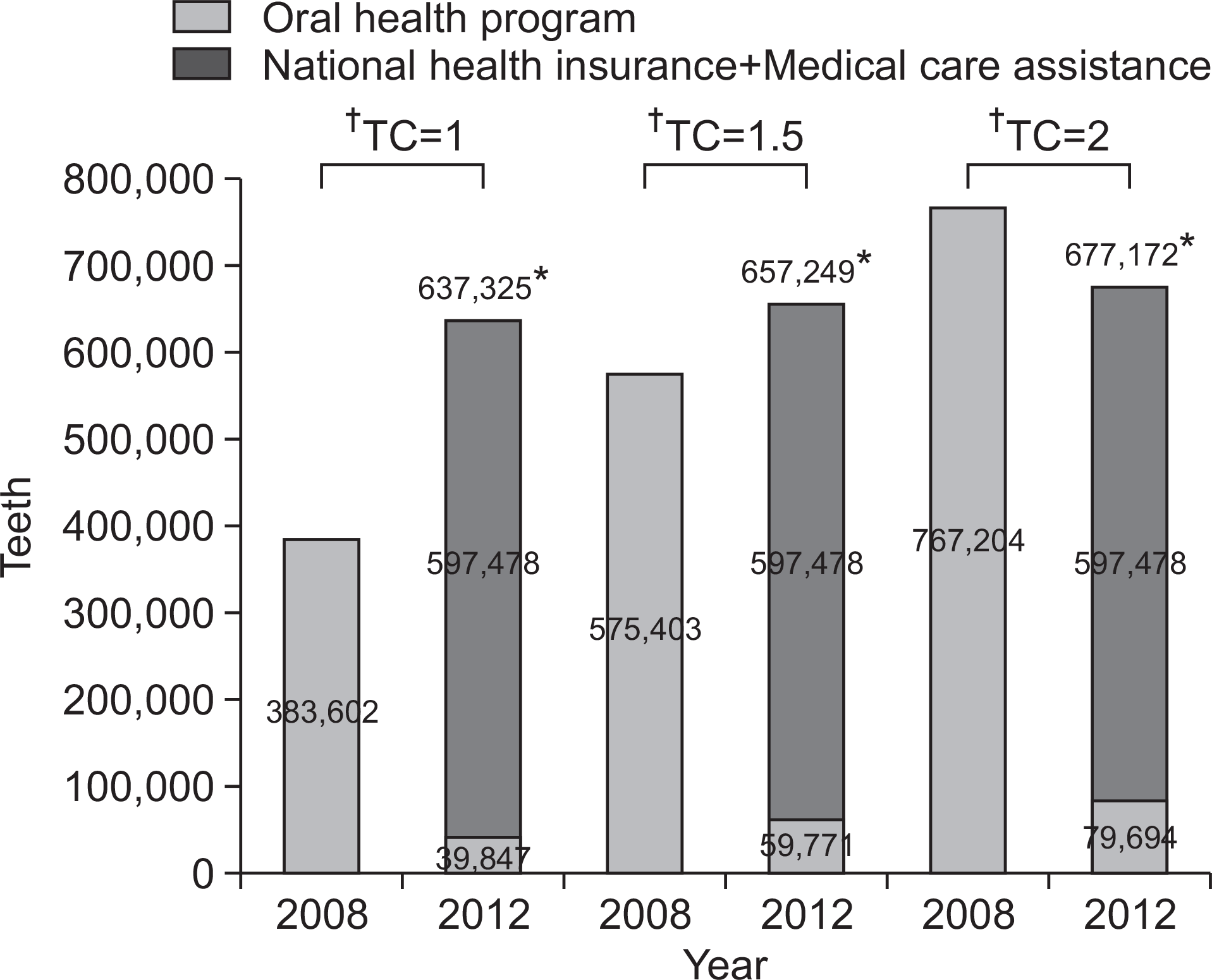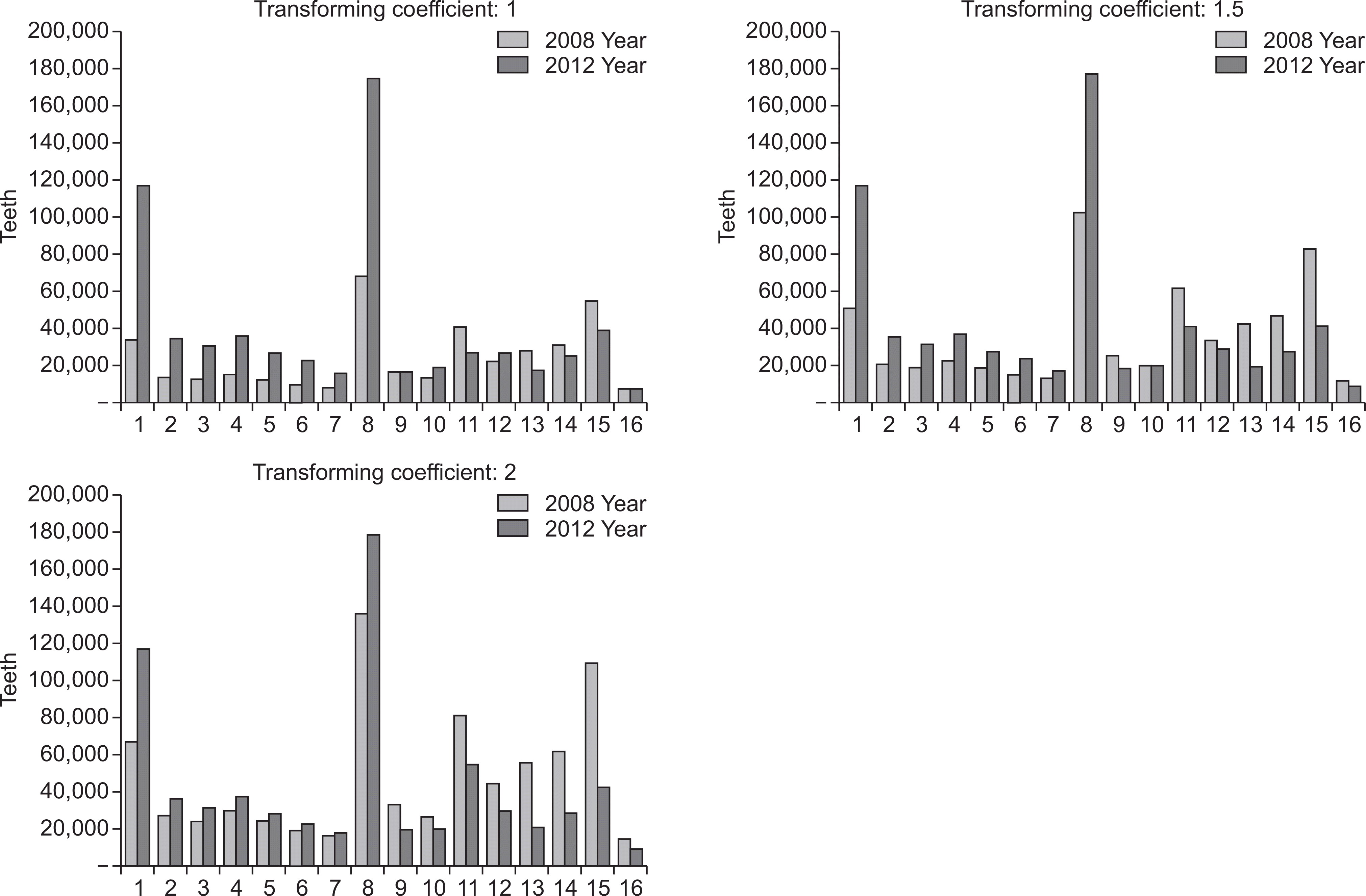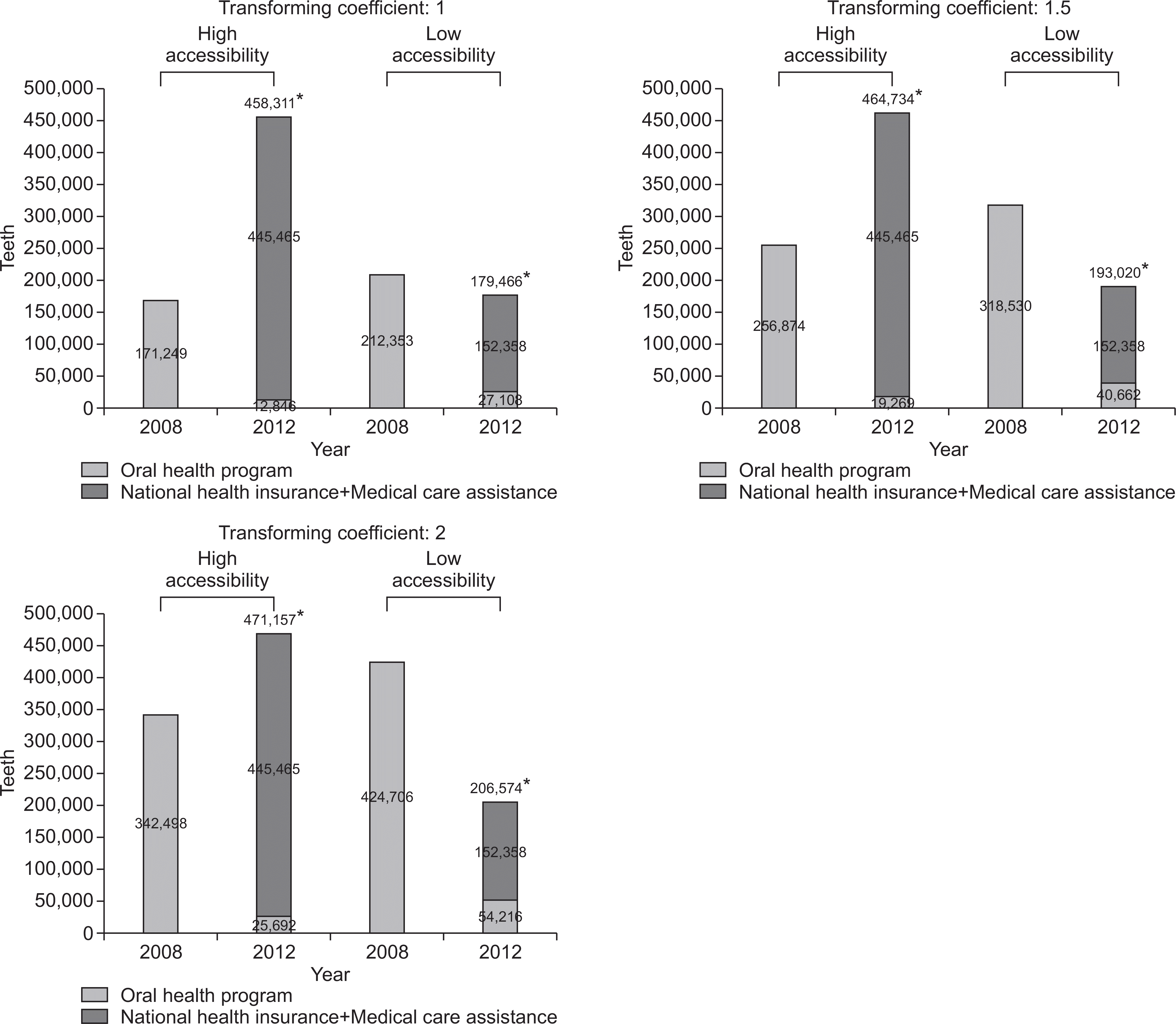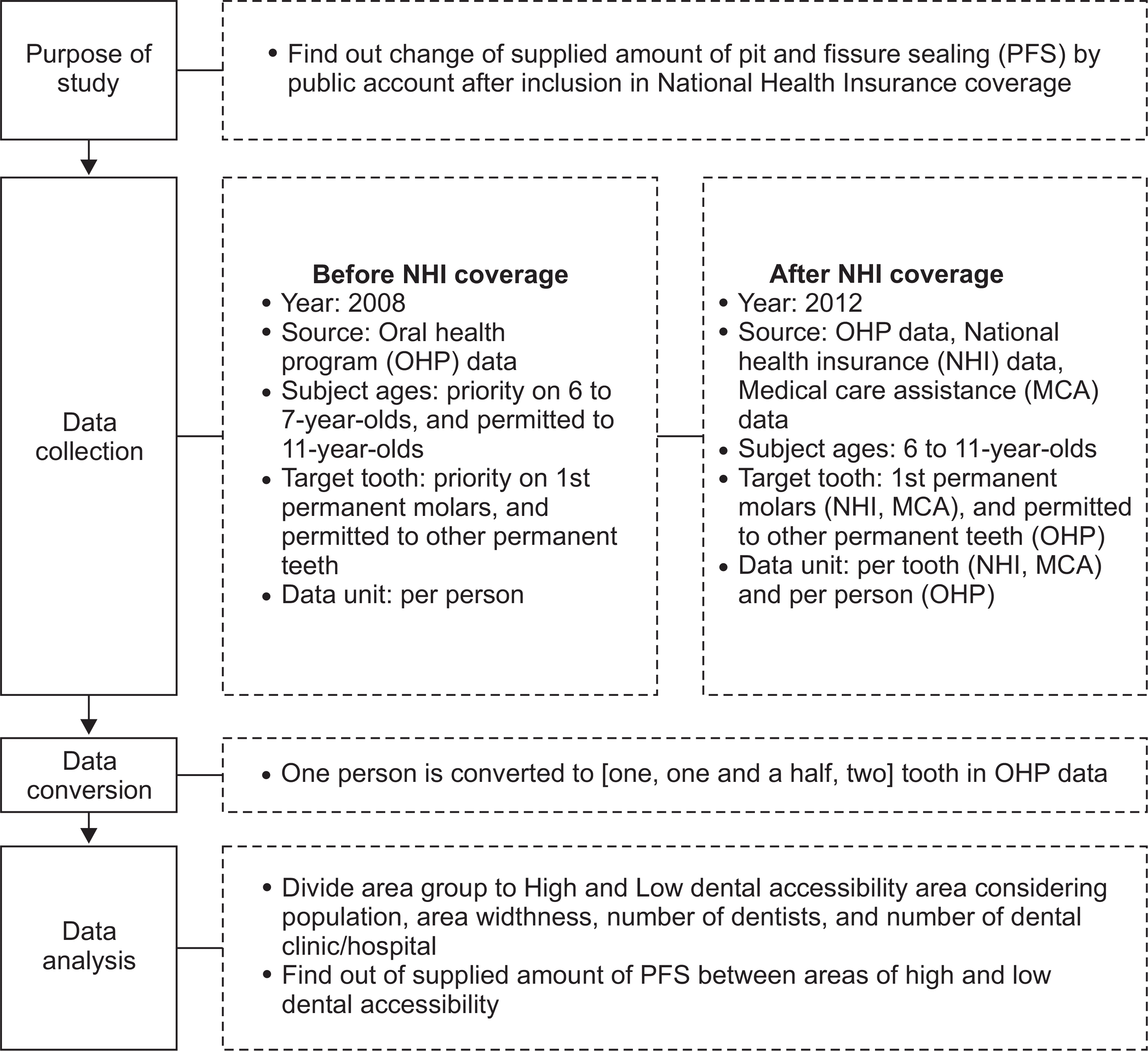Abstract
Objectives
The purposes of this study were to review changes in the amount of pit and fissure sealant (PFS) provided after the inclusion of PFS in treatments covered by the National Health Insurance (NHI) and to assess differences in the supplied amount between geographical areas where accessibility to dental care differs.
Methods
The years for comparison were selected based on data availability and the time of inclusion of PFS into NHI coverage. The selected pre-inclusion year was 2008, and the post-inclusion year was 2012. Data regarding the amount of PFS supplied were collected from the oral health program, NHI, and Medical care. To dichotomize areas by high and low dental care accessibility, we standardized the population size, number of dental institutions, and number of dentists in each group.
Results
We considered metropolitan areas and Gyeonggi Province as high dental care accessibility areas, while other provinces were considered as low dental care accessibility areas. Regardless of the transforming constant, the amount of PFS supplied increased in high dental care accessibility areas and decreased in low dental care accessibility areas after inclusion of PFS in NHI.
Go to : 
References
1. Lee GS. Concept and feature of medical social security. Financing & delivering health care. Gyechuk. 2002. 19–44.
2. Korea Ministry of Goverment Legislation. Legislation search, Oral health care law [Internet]. [cited 2014 Feb 01]. Available from:. http://www.law.go.kr/lsSc.do?menuId=0&p1=&subMenu=1&nwYn=1§ion=&query=%EA%B5%AC%EA%B0%95%EB%B3%B4%EA%B1%B4%EB%B2%95&x=0&y=0#liBgcolor0.
3. Ministry of Health and Welfare. 2012 Korean National Oral Health Survey. Seoul: Ministry of Health & Welfare;2012. p. 3–14.
4. Ahovuo-Saloranta A, Forss H, Walsh T, Hiiri A, Nordblad A, Makela M, et al. Sealants for preventing dental decay in the permanent teeth. Cochrane Database Syst Rev. 2013; 3:1–31.

5. Korea Institute for Health and Social Affairs. 2007 report of oral health services. Seoul: Korea Institute for Health and Social Af-fairs;2008. p. 92–94.
6. Lee KH, Kim JY, Song JH, Kim YH, Im KU, Jeong SY. Present state and prospect of public dental health service for children and adolescents in Korea. J Korean Acad Pediatr Dent. 2008; 35:578–588.
7. Korea ministry of government legislation. Legislation search, Concerning standard of medical care expenses on national Health Insurance [Internet]. [cited 2014 Feb 01]. Available from:. http://www.law.go.kr/lsSc.do?menuId=0&p1=&subMenu=1&nwYn=1§ion=&query=%EA%B5%AC%EA%B0%95%EB%B3%B4%EA%B1%B4%EB%B2%95&x=0&y=0#liBgcolor5.
8. Korea ministry of government legislation. Legislation search, National Basic Living Security Act [Internet]. [cited 2014 May 27]. Available from:. http://www.law.go.kr/lsSc.do?menuId=0&p1=&subMenu=1&nwYn=1§ion=&query=%EA%B5%AC%EA%B0%95%EB%B3%B4%EA%B1%B4%EB%B2%95&x=0&y=0#liBgcolor1.
9. Kim CY. Chapter3. Function and significance of health security system. Kim CY. Theories of health security. Hanul acad-emy;2009. p. 68–104.
10. Lee YJ. An study on the Inequality of health care resources distribution affected by regional characteristics. Critical Social Welfare Academy. 2005; 21:49–78.
11. Choi YH, Lee JH, Lee SG. Geographical disparities for oral health status in Korean adults. J Korean Acad Dent Health. 2009; 33:243–253.
12. National Health Insurance Corporation · Korean dental association. Strategy for increasing national health insurance benefit in dental expenditure in Korea. Seoul: National health insurance service · Korean dental association;2013.
13. Ministry of Health and Welfare. 2010 oral health services manual. Seoul: Ministry of Health & Welfare;2010. p. 1–5.
14. Gunchinews. pit and fissure sealant [Internet]. [cited 2014 Jun 08]. Available from:. http://www.gunchinews.com/news/articleView.html?idxno=28467.
15. OH YH. A GIS-based study of the distribution of major health manpower in Korea. 141th ed.Korea Institute for Health and Social Af-fairs;2008. 141:p. 59–72.
16. Park KD. Regional Disparity of Health Care Utilization: about space dependability. Korean Association for Public Administra-tion. 2012; 21:387–414.
17. Kim SJ, Lee HJ, Kim YS, Jeon JK, Chang KW. The recognition and attitude of student’s parents of elementary school on the sealant and its operation by dental hygienists. J Korean Acad Oral Health. 2012; 36:323–332.

18. Gunchinews. Over-estimating of pit and fissure sealant [Internet]. [cited 2014 Jun 08]. Available from:. http://www.gunchinews.com/news/articleView.html?idxno=22765.
19. Jin SB. Meaning of pit and fissure sealing in national health insurance coverage and Instructions on calim. J Korean Acad Dent Insurance. 2013; 4:30–36.
20. Kim JH, Hwang JM, Seong JM, Park YD. Awareness and needs about national health insurance coverage of pit and fissure sealants of dental service providers and consumers in the metropolitan area. J Korean Acad Oral Health. 2009; 33:608–616.
21. Kim IK, Choi YS, Park YD. A recognition study on sealant health insurance service of parents of an elementary students in a metro-politan area. J Korean Acad Oral Health. 2009; 33:575–584.
22. Kim HL, YEO JY. A Comparison of Korean Health Status and Health Care System Performance with OECD Countries. Health-welfare policy forum;2013. p. 89–103.
23. Ministry of Health & Welfare · Korea institute for health and social affairs. 2013 OECD Health data. Seoul: Ministry of Health & Welfare · Korea institute for health and social affairs;2013. p. 87–89.
24. Health insurance review and assessment service. Medical care [Internet]. [cited 2014 May 27]. Available from:. http://www.hira.or.kr/dummy.do?pgmid=HIRAA020020000000.
25. OECD. How’s Life? Measuring well-being Report. 2011. 37–55.
26. National assembly secretariat. A study on measures of statute revision for the Promotion of Nation’s Health. National assembly secre-tariat. 2011; 83–88.
27. Ministry of Health and Welfare. Uiryogeubyeo boninbudamje mich incentive doipbangan yeongu(Study on the cost sharing system in Korean medical care assistance and introduction of incentive). Seoul: Ministry of Health & Welfare;2006. p. 43–60.
28. Health Insurance Policy Institute. Geongangjungjin mich Jil-byeongyebang yeongyeokeseoui geongangbohem yeokhal seoljeong(Role set-up of national insurance coverage on domain of health care program on the health promotion). Seoul: Health Insurance Policy Institute;2012. p. 91–149.
29. National Health Insurance Corporation · Korea institute for health and social affairs. The 2013 Korea health panel Study. Seoul: National Health Insurance Corporation · Korea institute for health and social affairs;2014. p. 314–329.
Go to : 
 | Fig. 2.The amount of pit and fissure sealing by public account before and after National Health Insurance coverage. *Oral health program +National health insurance+Medical care assistance. †Transforming coefficient: Coefficient needed to transform unit of person to unit of teeth. |
 | Fig. 3.The publicly supplied amount of pit and fissure sealing by region. Note: 2008 year=Oral health program. 2012 year=Oral health program+National health insurance+Medical care assistance. 1=Seoul, 2=Busan, 3=Daegu, 4=Incheon, 5=Gwangju, 6=Daejeon, 7=Ulsan, 8=Gyeonggi, 9=Gangwon, 10=Chungbuk, 11=Chungnam, 12=Jeonbuk, 13=Jeonnam, 14=Gyeongbuk, 15=Gyeongnam, 16=Jeju. |
 | Fig. 4.The publicly supplied amount of pit and fissure sealing by dental care accessibility of cities. *Oral health program+National health insurance+Medical care assistance. |
Table 1.
Classification and characteristics of data
Table 2.
Extent standardized population, dental institutions, dentists by area
| Classification | Population* (Per 1 km2) | Dental institutions† (Per 1 km2) | Dentist‡ (Per 1 km2) | |||||||
|---|---|---|---|---|---|---|---|---|---|---|
| 2008 | 2012 | Ranking§ | 2008 | 2012 | Ranking§ | 2008 | Ranking | 2012 | Ranking | |
| Seoul | 1,055 | 833.1 | 1 | 7.1 | 7.7 | 1 | 9.9 | 1 | 10.9 | 1 |
| Busan | 286 | 217 | 2 | 1.3 | 1.5 | 2 | 1.8 | 2 | 1.9 | 2 |
| Daegu | 248 | 196.2 | 3 | 0.9 | 1 | 3 | 1.5 | 3 | 1.7 | 3 |
| Incheon | 219 | 178.3 | 4 | 0.8 | 0.9 | 4 | 1.1 | 5 | 1.3 | 4 |
| Gwangju | 208 | 159.9 | 5 | 0.8 | 0.9 | 4 | 1.2 | 4 | 1.3 | 4 |
| Daejeon | 199 | 157.5 | 6 | 0.7 | 0.7 | 5 | 0.9 | 6 | 1 | 5 |
| Ulsan | 91 | 76.4 | 7 | 0.3 | 0.3 | 6 | 0.4 | 7 | 0.4 | 6 |
| Gyeonggi | 86 | 65.1 | 8 | 0.3 | 0.3 | 6 | 0.3 | 8 | 0.4 | 6 |
| Gangwon | 26 | 21.3 | 9 | 0.1 | 0.1 | 7 | 0.1 | 9 | 0.1 | 7 |
| Chungbuk | 24 | 18.6 | 10 | 0.1 | 0.1 | 7 | 0.1 | 9 | 0.1 | 7 |
| Chungnam | 20 | 14.6 | 11 | 0.1 | 0.1 | 7 | 0.1 | 9 | 0.1 | 7 |
| Jeonbuk | 17 | 13.5 | 12 | 0.1 | 0.1 | 7 | 0.1 | 9 | 0.1 | 7 |
| Jeonnam | 14 | 12.3 | 13 | 0 | 0 | 8 | 0.1 | 9 | 0.1 | 7 |
| Gyeongbuk | 11 | 8.4 | 14 | 0 | 0 | 8 | 0 | 10 | 0.1 | 7 |
| Gyeongnam | 10 | 7.3 | 15 | 0 | 0 | 8 | 0 | 10 | 0 | 8 |
| Jeju | 7 | 5.1 | 16 | 0 | 0 | 8 | 0 | 10 | 0 | 8 |




 PDF
PDF ePub
ePub Citation
Citation Print
Print



 XML Download
XML Download